1972 TRIUMPH BONNEVILLE CARRIES OVER
Coming one year after the major redesign that came in 1971, and one year before the major redesign coming in 1973 (displacement bump to 750cc, shorter barrels, front disk brake, 5-speed and fresh styling), Triumph sort of ‘took a break’ for the 1972 model year. Few changes were made from the 1971s. One major change was lowering the towering seat height of the early bikes from a lofty 34 inches, down to a more reasonable 32.5 inches. This happened midway through the 1972 model year. Of course, there was a color change for 1972, there always is. The correct color combo, by the way is gold and white (like the 1972 Triumph Bonneville pictured near the bottom of the page. US-spec bikes got Gold and White, UK-spec bikes could option for White and Gold. The red-and-silver paint scheme pictured below is not correct for a 1972 Triumph Bonneville. But it didn’t stop him from winning his class at the Clubmans Show in 2017, restored as it was to better-than-new condition.
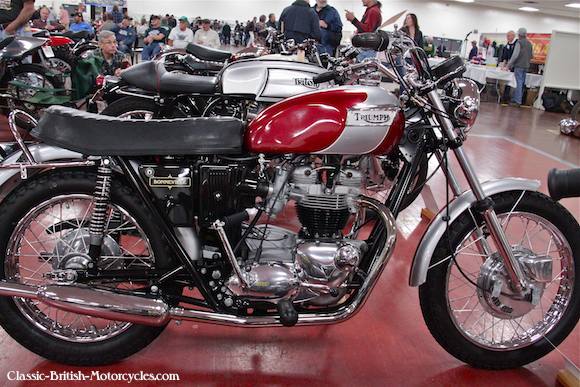
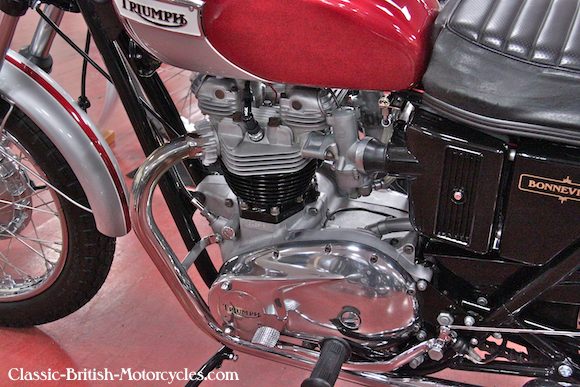
ENGINE MODS
The 1972 Triumph Bonneville T120 650 was largely carried over from 1971, but of course there were changes. The 1972 model year officially started at Engine #HG30870. Changes to the engine were relatively few. At Engine #XG42304, a new cylinder head & rocker boxes arrived. The new rocker box castings had large inspection covers to replace the screw-on caps, allowing far better access for adjusting the valves. The new head ditched the old-style screw-in steel exhaust pipe flanges in favor of a machined recess into which the header pipe simply slipped in, to be held in place by the exhaust mounts downstream. It featured a clamp-on finned alloy ‘glamour-ring’ to replicate the old steel exhaust clamps. The new system was an abysmal failure. Not only did it leak badly, but the vibrating steel exhaust pipes ground the holes in the head out, making them larger & oblong, exacerbating the exhaust leaks. Many owners (myself included) had the heads machined to accept the older-style screw-in steel flanges & used clamps.

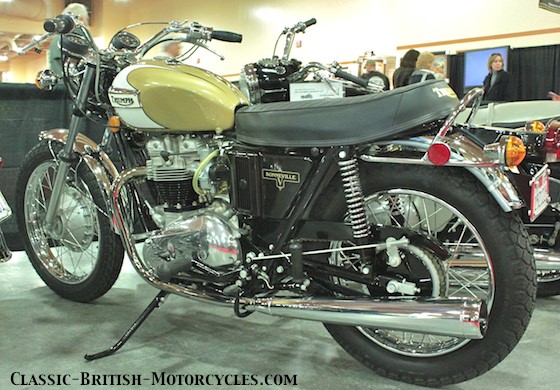
1972 TRIUMPH BONNEVILLE : AT LAST – 5 SPEEDS
Minor revisions were made to the clutch actuator mechanism for the 1972 Triumph Bonneville. And of course, the 5-speed Quaife gearbox became available as an option. These 5-speed bikes received a “V” after their model designation (ie: T120RV) & a Roman Numeral “V” on the black side covers under the “Bonneville” transfer.
1972 TRIUMPH BONNEVILLE : LOWERED SADDLE
The excessive seat height was the main change in the chassis department. By reworking the rear frame & the seat itself, they dropped it from a towering 34″ down to a more reasonable 32-1/2″. But stocks of the old, taller frame were used up first, so the lower seat height began with Engine #CG50414. Some dealers couldn’t wait & came up with ‘quick fixes’ themselves, like shortening the forks & shocks, and removing padding from the seat. The frame changes required alterations to the Girling rear shocks, the seat, battery box, air filters, coil mounts & side panels. Most everything else carried over relatively unchanged.
1972 TRIUMPH BONNEVILLE COLOR COMBOS
The 1972 Triumph Bonneville color scheme was Tiger Gold over Cold White, with black pinstriping separating the two colors.
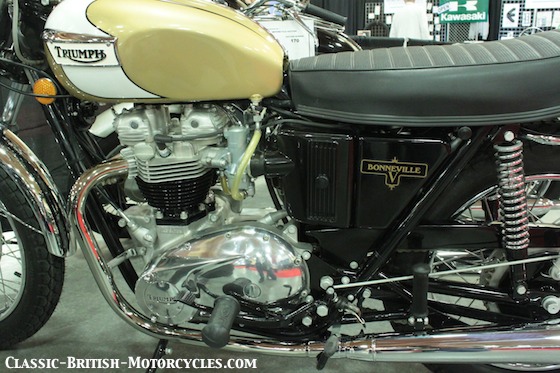
ABOVE: Every detail is correct on this pristine 1972 Triumph Bonneville. Note how the air filters are now contained within the side covers, as opposed to the pre-1971 “can”-type which clamped to the carbs. The grilles on the side covers are phony, they’re actually solid. Instead, air is drawn through snorkels that extend to just above the swingarm pivot.
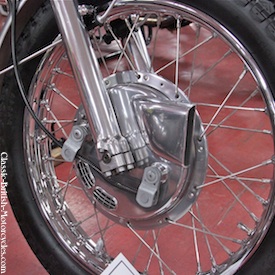 |
 |
1972 TRIUMPH BONNEVILLE GETS CONICAL HUBS
While some Triumph traditionalists opposed the ‘new look’ of the oil-in-frame Triumphs, they were very handsome bikes. One of the many aspects that was not only attractive but unique were the conical hubs, front and rear. These early front brake systems didn’t have long enough actuator arms to give the brake cable the leverage it needed to brake hard, a shortcoming that was overcome with longer arms. But, the looks were radical for the time, and still very attractive and rather exotic today. Custom bike builders love them because there’s nothing else like them, and they’re fairly cheap and easy to find. By 1973 they’d replaced this gorgeous front hub with a disk brake. A welcome improvement, practically speaking, but not as pretty as the conical hub setup. The rear brakes were also conical, starting in 1971, and remained in use through the 1975 model year, replaced in 1976 by a rear disk brake, when the switch was made to left-foot shifting.
1972 Triumph Bonneville SPECIFICAITONS
|
T120R Bonneville Engine type Displacement Bore & Stroke Compression Carburetors Ignition Engine output Primary drive Primary sprockets Clutch Gearbox, standard Ratios, overall: 1st, bottom 2nd 3rd 4th, top Gearbox, optional Ratios, overall: 1st, bottom 2nd 3rd 4th 5th, top Final drive Final drive sprockets Frame type Suspension, front Suspension, rear Brake, front Brake, rear Tire, front Tire, rear Fuel capacity Wheelbase Seat height Ground clearance Weight |
Roadster Air-cooled OHV vertical twin 649cc / 40.0 ci 71mm X 82mm / 2.79″ X 3.23″ 9.0:1 2- Amal Concentrics R930/9, 30mm Battery & coil, Lucas 49 bhp @ 6200 rpm 3/8″ triplex X 84 links Engine 29T X Clutch 58T Multi-plate, wet 4-speed constant-mesh, right-foot shift 11.8:1 8.17:1 6.76:1 5.84:1 5-speed constant-mesh, right-foot shift 12.78:1 9.07:1 6.92:1 5.89:1 4.95:1 5/5″ X .400″ X 3/8″ chain X 106 links Gearbox 19T X Rear 47T All-welded, oil-bearing large-tube backbone Telescopic fork, hydraulic damping 2-way Swing arm, 2 Girling dampers 8″ TLS drum, conical hub 7″ SLS drum, conical hub 3.25″ X 19″ Dunlop, ribbed 4.00″ X 18″ Dunlop, universal 3 Imp gal (US) / 4 Imp gal (UK & export) 56″ / 142 cm 34″ / 87.5 cm 7″ / 18 cm 395 lbs/ 179 kg |


